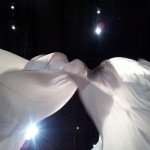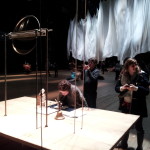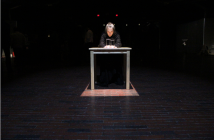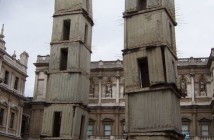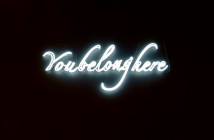I wanted to like Ann Hamilton’s ‘the event of a thread’ and I did, but not in the ways I anticipated. Reading about the elements of Hamilton’s installation at the Park Avenue Armory (NYC) I imagined an experience of transcendence and freedom: pigeons soaring, high-flying swings, a fluttering white curtain strung across the 55,000 square foot hall, and the "sounds of glee" Roberta Smith and the Armory’s publicity promised. The actual experience is surprisingly earth-bound and sober, and if one reads the artists statement (pdf) that would seem to be the point, but it’s still a bit of a let-down after the collective critical misreading which promised a sociable experience filled with childlike fun. Here is an excerpt from Hamilton's full text:
"I can remember the feeling of swinging—how hard we would work for those split seconds, flung at furthest extension, just before the inevitable downward and backward pull... time stopped and then suddenly rushed again toward us. We would line up on the playground and try to touch the sky, alone together.... reading also sets us in motion. We fall between a book’s open covers... As a child, I could spend hours pressed against the warmth of my grandmother’s body listening to her read, the rustling of her hand turning the page, watching the birds and the weather outside, transported by the intimacy of a shared side by side." (PDF here)
Kristy Edmunds, Consulting Artistic Director at the Armory, said "Hamilton’s installation will draw together human actions—including speaking, singing, reading and writing—with the poetic potential of physical forces, such as velocity, time, and sound." Instead, the scale and acoustical challenges of the space combined with the physical and conceptual design of the installation do just the opposite. Each participant becomes isolated against the whole as they line up to wait for the swings, "alone together."
The visitor is first greeted by the backs of two "attendant readers" seated at a rustic wooden table on which pigeons are stacked in wooden crates. It is disappointing to discover that the flock of pigeons do not soar across the armory, rather they are caged in tight quarters and strangely quiet. Several viewers said they preferred the birds in cages to avoid the perils of free-falling feces, but an artist of Hamilton's prowess in creating environments might have conceived of a more poetic way of incorporating live animals, unless the intent was to evoke feelings of claustrophobia and disappointment.
The readers recite the scrolls into vintage microphones while costumed in wooly capes made from recycled newspapers (or some other environmentally sensitive material) studiously ignoring each other and the audience. On the opposite side of the hall a lone scribe writes by hand about "human emotion and places far away," in the earnest words of the artist.
The day I visited, the female readers wore their hair in tightly wrapped braids and the men were close-cropped like monks. The effect is both silly and sentimental—somewhere between the aesthetics of the "Hunger Games" and the Von Trapp family’s drab outfits before Julie Andrews used the drapery to make new costumes. The Sound of Music association made me giggle when I realized that the 42 radios transmitting the gloomy readings were contained in brown paper packages tied up with string. Many New Yorkers at the exhibition seemed wary of the packages in this age of "If you see something, say something."
Any hope of feeling part of a larger group of art-appreciators is thwarted by the white cloth which bisects the space, preventing the swingers on one side from seeing those on the other. I suppose one can interpret from the artists statement that the opposing banks of swings separated by a cloth which flutters like a page are perhaps the physical coming together of the feeling of swinging and that of "falling between a book’s open covers," but without the artists text to elucidate this connection the experience is frustrating.
The swings themselves are lovely and the feeling of swooping back and forth in slow-moving arcs is transporting, but any parent will tell you that swings do not encourage sharing or sociability. Swings encourage parallel rather than cooperative play and the voices echoing through the armory suggested that not all visitors were well versed in taking turns (though that may have been mostly my family).
In Art History After Modernism Hans Belting wrote of "the desire for culture that is entertaining rather than instructing and that offers a spectacle in which we take part. . . Rather than continuing to represent culture and history, art engages in rituals of remembrance. . ." The readers and writers in ‘event of the thread’ were pedantic and disjointed from the main event—the swings—as if Hamilton was loathe to leave behind all that is instructional in high-culture and mistrustful of the pleasures of participatory "spectacle." Why can’t visitors participate in the reading and writing? Why pretend the readers and writers can’t see the visitors?
This installation does, as Roberta Smith wrote, bring "fun to a body of work that has often taken itself a bit too seriously" and I hope that Hamilton continues this exploration of less pedantic work. I also hope she develops more faith in the ability of her public to engage in cooperative rather than parallel play, without which viewers are infantilized by readers and pigeons and slow-moving swings—a few of Hamilton's favorite things.
- The large white curtain that divides the Park Avenue Armory.
- The scribe at work during event of the thread.
the event of a thread is on view at the Park Avenue Armory in New York through January 6, 2013.


